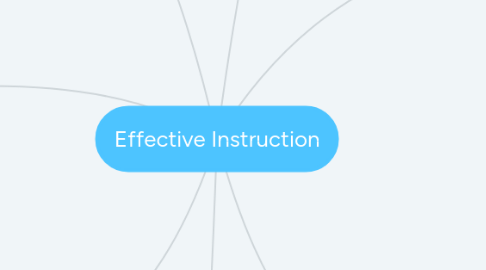Effective Instruction
作者:EmmaGrace Felton


1. Cognitive Strategy Instruction
1.1. A tool to help students develop the necessary skills to be self-regulated learners.l
1.2. Gives students strategies to become better learners.
1.3. Good for students with learning disabilities to help give them strategies to be successful.
1.4. 6 Stages of the CSI Model Stage 1: Develop and Activate Background Knowledge Stage 2: Discuss the Strategy Stage 3: Model the Strategy Stage 4: Memorize the Strategy Stage 5: Support the Strategy Stage 6: Independent Performance
1.5. It is important to give students specific feedback when using this type of instruction.
2. Bloom's Taxonomy
2.1. Three domains of educational activities and learning.
2.1.1. Cognitive
2.1.1.1. Mental skills
2.1.1.1.1. Remembering Understanding Applying Analyzing Evaluating Creating
2.1.2. Affective
2.1.3. Psychomotor
3. Direct and Explicit Instruction
3.1. Includes examples, guidance through new material, and explicit instructions.
3.2. Helps less-skilled learners through specific task learning strategies.
3.3. Focuses on retaining long-term memory to build on what students already know and add to that knowledge.
3.4. Examples of work for which the problem has already been solved, showing each step of the process are important for teaching students how to perform tasks.
3.5. Better for students who are learning new concepts and ideas for the first time.
4. Applied Behavior Analysis
4.1. Many behaviors of students are learned, so students can be taught new behaviors.
4.2. Antecedent is an event or stimulus that comes before a behavior and can increase the chance of that behavior happening again in the future.
4.3. Classroom schedules should be kept consistent for the best learning of all students.
4.4. Classroom rules should be developed and stated in a clear and positive manner. They should be enforced throughout the year.
5. Universal Design for Learning
5.1. Teachers deliver content in multiple ways.
5.2. Students are active learners that engage and analyze the content.
5.3. Learning environment encourages students to explore the content based on what they are interested in and what they are capable of.
5.3.1. Students show their skills through multiple methods.
5.4. Addresses needs of all students, from the gifted and talented students, to those with disabilities.
5.5. Used when designing curriculum
6. Differentiated Instruction
6.1. An approach where teachers modify their curriculum and instruction to maximize the learning for all students.
6.2. It is a framework for implementing strategies.
6.3. Uses evidence based strategies.
6.3.1. Examples of evidence based strategies include:
6.3.1.1. Grouping students for instruction purposes
6.3.1.2. Assessing student readiness
6.3.1.3. Using a variety of teaching approaches
6.3.1.4. Use the results of assessment to adjust the instruction as needed.

